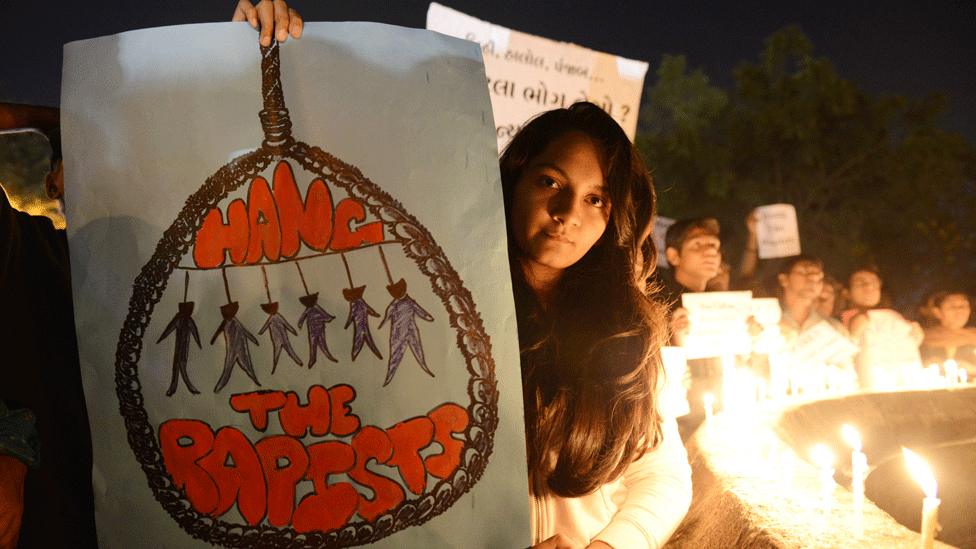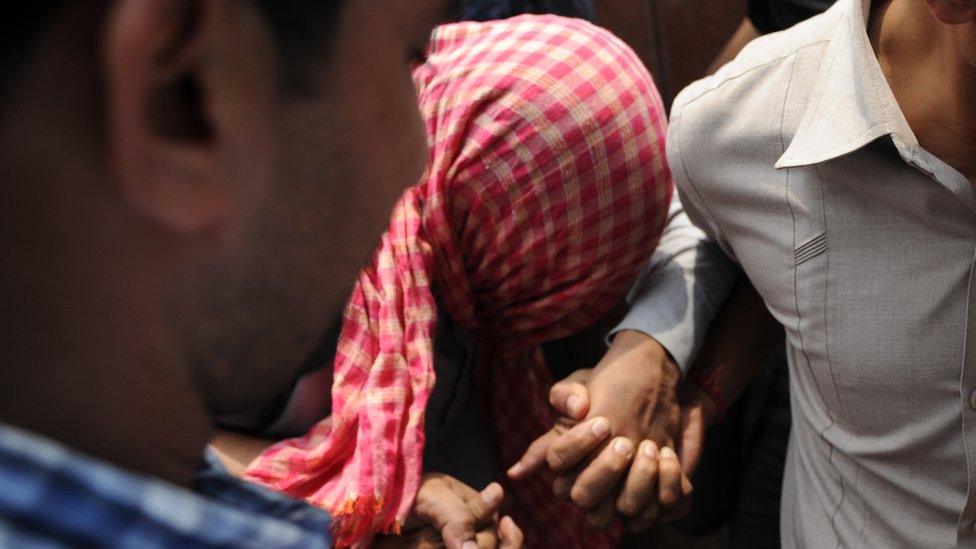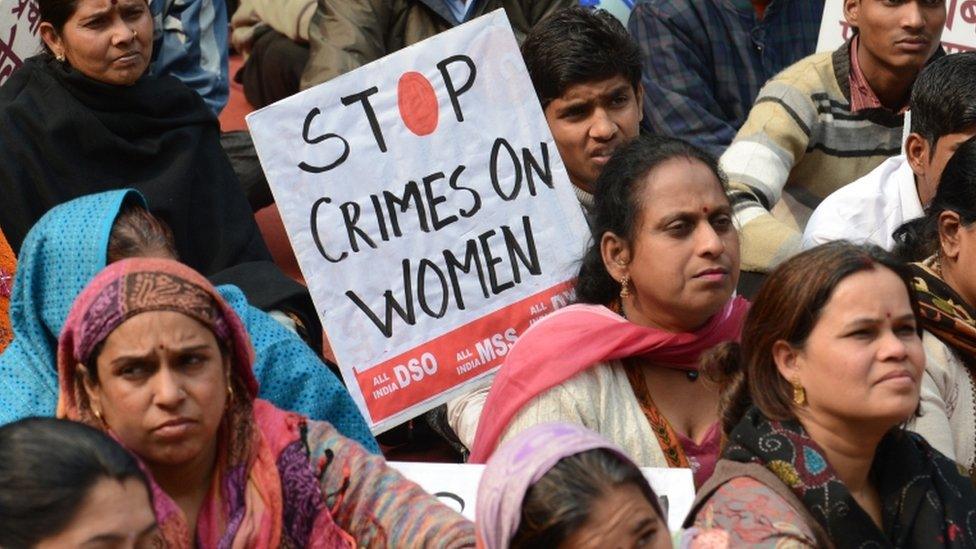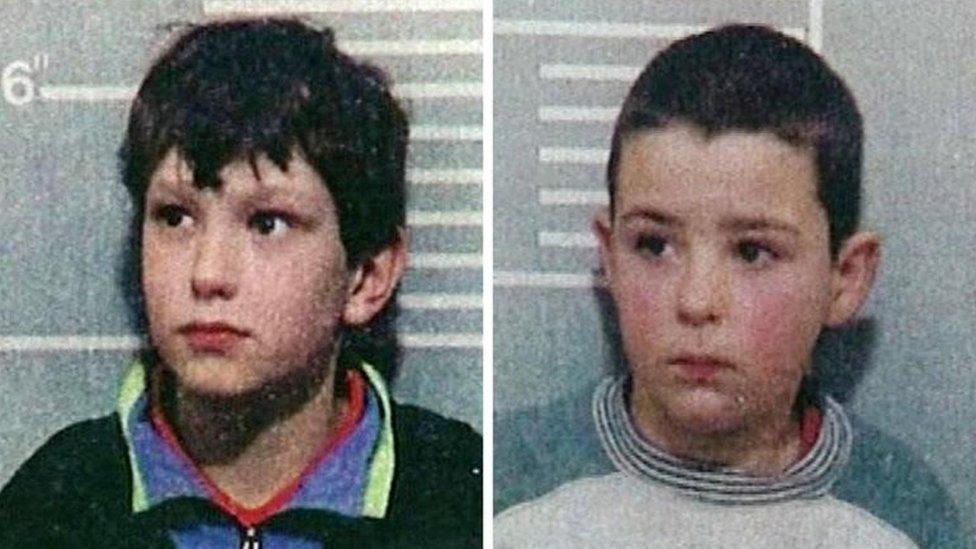Delhi gang rape: Second chance for teenage rapist?
- Published

Under Indian law, the identity of juvenile offenders cannot be revealed
Three years after the brutal gang rape - and subsequent death - of a 23-year-old physiotherapy student on a bus in the Indian capital, one of her rapists - a minor at the time of the crime - is set to be freed. But with public outrage growing over his release, he will be handed over to a charity for his protection and rehabilitation, writes the BBC's Geeta Pandey in Delhi.
The crime caused global outrage and the young woman's attackers are among the most hated men in India.
As the victim - who can't be named under Indian laws - lay in hospital fighting for her life, the horrific details of the assault began to emerge, with some reports claiming that the juvenile had been the most brutal.
There were calls to try him as an adult, with many saying his punishment should be commensurate with his crime.
The teenager was convicted of rape and murder and sentenced to three years in a reform facility, the maximum term possible for a juvenile in India.

Case timeline

16 December 2012: A 23-year-old physiotherapy student is gang-raped by six men on a bus in Delhi, her male friend is beaten up and the pair are thrown out after the brutal assault
17 December: Key accused Ram Singh, the bus driver, is arrested. Over the next few days, his brother Mukesh Singh, gym instructor Vinay Sharma, fruit seller Pawan Gupta, a helper on the bus Akshay Thakur, and the 17-year-old juvenile, who cannot be named, are arrested.
29 December: The victim dies in hospital in Singapore from injuries sustained during the assault; body flown back to Delhi
30 December: Cremated in Delhi under tight police security
11 March 2013: Ram Singh dies in Tihar jail; police say he hanged himself, but defence lawyers and his family allege he was murdered
31 August: The juvenile is found guilty and sentenced to three years in a reform facility
13 September: The four adult defendants are convicted and given the death penalty by the trial court
13 March 2014: The Delhi high court confirms the death sentence
March - June: The convicts appeal in the Supreme Court and the death sentences are put on hold until the court takes a decision

During his trial, it was never proved that the teenager was any more brutal than the others, external, but this fact has been ignored by most people, stunned by the brutality heaped on the victim.
Now with the date for his release nearing, public resentment is running high - many people I spoke to in the past few days said they wanted to "hang him from the nearest pole" or "organise a public lynching" for him. The more lenient said they wanted to see him locked up in a jail forever and forgotten.
The victim's parents have petitioned the National Human Rights Commission to stop his release and a BJP politician has appealed to the Delhi high court, external to ensure that he is not freed until it is proved that "he has reformed and is not a menace to society".
The authorities are tight-lipped about their plans for him, but the BBC has learnt from reliable sources that arrangements have been made to hand him over to a non-governmental organisation for rehabilitation.

The vitriolic media coverage - mostly based on unsubstantiated leaks - has created a distorted image in the minds of most people, activists say
An official at the juvenile home in Delhi's Majnu Ka Tila area, where the young man - he's now 20 - has been lodged for the past three years, told the BBC he must be given another chance.
"The boy is alright. He has expressed remorse for his actions. He said he made a mistake. He was a mere child at the time of the crime. I asked him why he did what he did. He said he was staying with adults and wanted to prove to them that he could do what they could do," the official said.
When he was brought to the remand home on 18 December 2012 the teenager was suffering from trauma and underwent surgery to remove his appendix at a government hospital a week later, the official said.

There were calls to try the boy as an adult, with many saying his punishment should be commensurate with his crime
During his stay at the home - parts of which were in solitary confinement - he was assigned tutors who taught him basic Hindi, English and Maths and the official said "he can now sign his name in English and Hindi".
He was also taught to cook, how to stitch clothes and given guitar lessons.
"He's a good cook, he can make really nice potato chops [patties], matar paneer [peas and cottage cheese curry] and rajma [kidney beans]. He's also developed as a tailor who can do a really good job stitching pants and shirts," the official said.
"Once he's free, he can set up a tea stall or work as a tailor. I think we have succeeded a fair bit in moulding him and he should be given a chance to start over," he added.

During his time in the remand home, he was taught cooking, how to stitch clothes and given guitar lessons
In the weeks and months after the crime, the teenager, who came from an impoverished family in rural Uttar Pradesh, told shelter officials that he worried about his family and wanted to return home once released.
"But he has access to television and he has been watching the news, he is aware of the negative sentiments against him and is fearful for his life," a child rights activist who met him recently told the BBC. "The media has turned him into a monster, a demon, they said he pulled out the victim's intestines."
In recent days, there have been media reports suggesting he may now be turning jihadi. , external
Officials and activists say all this hype, the vitriolic media coverage - mostly based on unsubstantiated leaks - has created a distorted image in the minds of most people, and they fear he will not be safe outside. So a plan is being worked out to ensure his identity remains a secret.

The gang rape caused global outrage
"Under the law, the identity of a juvenile offender has to be protected. An individual care plan has to be worked out for him and he has to be rehabilitated," child rights activist Bharti Ali told the BBC.
"His name can never be revealed, nor can his photograph be shown. And his records have to be destroyed after a maximum of seven years," Ms Ali added.
The biggest problem the Juvenile Justice Board (JJB) is facing is that his identity is already partially revealed - in the weeks after the crime and again with his release becoming imminent - journalists have converged on his family home.
"But the board can issue an injunction, putting a ban on the media from carrying any report which could further reveal his identity," Ms Ali said.

The family of the young man cannot be identified for legal reasons
In India, there's no precedent for "after care" for children in conflict with law - it's been used largely for children who have no families and need care. But countries around the world have used it successfully and activists say India will need to draw on their experience to deal with this case.
It may not be easy - the highly competitive and rapacious Indian media will go to any length to find him. But, Ms Ali says, it must be done.
"You can't tell him that he can't lead another life, that he can only be a criminal. As a society we must do every thing to rehabilitate him and give him another chance."

Other notorious child killers

Jon Venables (left) and Robert Thompson after their arrest on 20 February 1993
Robert Thompson and Jon Venables were both 10 when they abducted and murdered two-year-old James Bulger in 1993. The boys abducted the toddler while he was in a shopping mall in Liverpool with his mother, took him to a railway line where they tortured him and killed him. They left his body on the track where it was discovered two days later. The picture, captured on CCTV, of Bulger being led away by hand was to become one of the most infamous images of the case. In November 1993 Thompson and Venables were convicted of murder. They were sentenced to secure youth accommodation with a recommendation that they serve at least eight years in jail. In June 2001, they were released on life licence and given new, secret identities.
Sajal Barui was 16 when he murdered his father, stepmother, and stepbrother, external in Kolkata (then Calcutta) along with five of his friends in November 1993. Since in those days, anyone above the age of 15 was treated as an adult, he was tried in a regular court and given the death penalty, which was later commuted to life in jail. He has never expressed remorse for his crimes.
Eric Smith was 13 when he killed four-year-old Derrick Robie, external on 2 August 1993 in a small New York village. He was convicted in 1994 and sentenced to nine years in prison - the maximum term then available for juvenile murderers. While in prison, he wrote a letter to Robie's family saying he was "truly sorry" for his crime. He has been denied parole several times and remains in jail.
